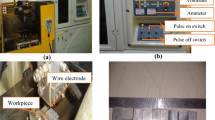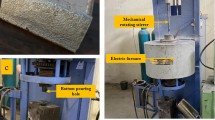Abstract
This research aimed to investigate the effects of different electrodes on the performance of electric discharge machined Al6061-SiC-7.5 wt% composite fabricated by squeeze casting process. The effects of three most significant input parameters including current intensity, pulse duration, and duty cycle on material removal rate (MRR), surface roughness (Ra), and electrode wear ratio (EWR) were investigated using copper, brass, and stainless steel electrodes. To improve the machining performance, graphene nanoparticles (4 wt%) were contaminated in dielectric fluid. Response surface methodology (RSM) based on central composite design was employed for design of experiments and development of mathematical models. Adequacy and validity of developed mathematical models were verified by ANOVA and confirmatory tests respectively. For multi-response optimization, desirability function approach was used to identify the optimum input parameters. For all electrodes, current intensity was observed as the most significant input parameter influencing MRR, Ra, and EWR followed by pulse duration and duty cycle. Comparative analysis revealed brass electrode as better option for MRR and Ra. Stainless steel, on the other hand, was identified as a better alternative for EWR. While taking copper as reference, 23.2% higher MRR and 20.3% better surface finish were achieved through brass electrode as compared to stainless steel electrode which provided 35.3% and 32.3% less MRR and surface finish respectively. EWR for stainless steel and brass electrode decreased by 25% and increased by 45.5% respectively with reference to copper. Multi-response optimization yielded compound desirability of 81%, 78.8%, and 77.1% for copper, brass, and stainless steel electrodes respectively for the machining of Al6061-SiC-7.5 wt% composite.
Similar content being viewed by others
References
Velmurugan C et al (2011) Experimental investigations on machining characteristics of Al 6061 hybrid metal matrix composites processed by electrical discharge machining. Int J Eng Sci Technol 3(8):87–101
Torralba JM, da Costa CE, Velasco F (2003) P/M aluminum matrix composites: an overview. J Mater Process Technol 133(1):203–206
Surappa M (2003) Aluminium matrix composites: challenges and opportunities. Sadhana 28(1–2):319–334
Ozben T, Kilickap E, Çakır O (2008) Investigation of mechanical and machinability properties of SiC particle reinforced Al-MMC. J Mater Process Technol 198(1):220–225
Lauwers B, Kruth JP, Liu W, Eeraerts W, Schacht B, Bleys P (2004) Investigation of material removal mechanisms in EDM of composite ceramic materials. J Mater Process Technol 149(1–3):347–352
Yan BH, Tsai HC, Huang FY (2005) The effect in EDM of a dielectric of a urea solution in water on modifying the surface of titanium. Int J Mach Tools Manuf 45(2):194–200
Joshi SN, Pande SS (2010) Thermo-physical modeling of die-sinking EDM process. J Manuf Process 12(1):45–56
Jahan M, Wong Y, Rahman M (2009) A study on the fine-finish die-sinking micro-EDM of tungsten carbide using different electrode materials. J Mater Process Technol 209(8):3956–3967
Sivasankar S, Jeyapaul R, Kunhahamed P (2013) Performance study of tool materials and optimisation of pulse duration on EDM of zirconium di boride. Int J Mach Mach Mater 14(2):123–141
Gopalakannan S, Senthilvelan T (2013) EDM of cast Al/SiC metal matrix nanocomposites by applying response surface method. Int J Adv Manuf Technol 67(1–4):485–493
Torres A, Luis C, Puertas I (2015) Analysis of the influence of EDM parameters on surface finish, material removal rate, and electrode wear of an INCONEL 600 alloy. Int J Adv Manuf Technol 80(1–4):123–140
Singh PN et al (2004) Electric discharge machining of Al–10% SiCP as-cast metal matrix composites. J Mater Process Technol 155:1653–1657
Mohan B, Rajadurai A, Satyanarayana K (2004) Electric discharge machining of Al–SiC metal matrix composites using rotary tube electrode. J Mater Process Technol 153:978–985
Wang CC, Yan BH (2000) Blind-hole drilling of Al2O3/6061Al composite using rotary electro-discharge machining. J Mater Process Technol 102(1):90–102
Mohan B, Rajadurai A, Satyanarayana KG (2002) Effect of SiC and rotation of electrode on electric discharge machining of Al–SiC composite. J Mater Process Technol 124(3):297–304
Gopalakannan S, Senthilvelan T (2013) A parametric study of electrical discharge machining process parameters on machining of cast Al/B4C metal matrix nanocomposites. Proc Inst Mech Eng B J Eng Manuf 227(7):993–1004
Seo Y, Kim D, Ramulu M (2006) Electrical discharge machining of functionally graded 15–35 vol% SiCp/Al composites. Mater Manuf Process 21(5):479–487
Atefi R et al (2012) The influence of EDM parameters in finishing stage on surface quality, MRR and EWR. Res J Appl Sci Eng Technol 4(10):1287–1294
Prabhu S, Vinayagam B (2010) Analysis of surface characteristics of AISI D2 tool steel material using electric discharge machining process with single wall carbon nano tubes. Int J Eng Technol 2(1):35–41
Khundrakpam NS et al (2014) Investigation and modeling of silicon powder mixed EDM using response surface method. Int J Curr Eng Technol 4(2):1022–1026
Harmesh K, Davim JP (2010) Role of powder in the machining of Al-10%Sicp metal matrix composites by powder mixed electric discharge machining. J Compos Mater 45(2):133–151
Mohanty S et al. (2017) Multi-objective parametric optimization of nano powder mixed electrical discharge machining of AlSiCp using response surface methodology and particle swarm optimization. Alex Eng J https://doi.org/10.1016/j.aej.2017.02.006
Gopalakannan S, Senthilvelan T (2014) Optimization of machining parameters for EDM operations based on central composite design and desirability approach. J Mech Sci Technol 28(3):1045–1053
Kanlayasiri K, Jattakul P (2013) Simultaneous optimization of dimensional accuracy and surface roughness for finishing cut of wire-EDMed K460 tool steel. Precis Eng 37(3):556–561
Alidoosti A, Ghafari-Nazari A, Moztarzadeh F, Jalali N, Moztarzadeh S, Mozafari M (2013) Electrical discharge machining characteristics of nickel–titanium shape memory alloy based on full factorial design. J Intell Mater Syst Struct 24(13):1546–1556
Jung JH, Kwon WT (2010) Optimization of EDM process for multiple performance characteristics using Taguchi method and Grey relational analysis. J Mech Sci Technol 24(5):1083–1090
Somashekhar KP, Ramachandran N, Mathew J (2010) Optimization of material removal rate in micro-EDM using artificial neural network and genetic algorithms. Mater Manuf Process 25(6):467–475
Lin C, Lin J, Ko T (2002) Optimisation of the EDM process based on the orthogonal array with fuzzy logic and grey relational analysis method. Int J Adv Manuf Technol 19(4):271–277
Montgomery DC (2017) Design and analysis of experiments. John wiley & sons
Ali MA et al (2018) Evaluating the effects of as-casted and aged overcasting of Al-Al joints. Int J Adv Manuf Technol 96(1–4):1377–1392
Demir H, Gündüz S (2009) The effects of aging on machinability of 6061 aluminium alloy. Mater Des 30(5):1480–1483
Novoselov KS et al (2005) Two-dimensional gas of massless Dirac fermions in graphene. Nature 438(7065):197
Karamitaheri H, Pourfath M, Faez R, Kosina H (2013) Atomistic study of the lattice thermal conductivity of rough graphene nanoribbons. IEEE Transactions on Electron Devices 60(7):2142–2147
Tseng K-H et al (2018) Preparation of graphene through EDM interfered with CO2. J Clust Sci 30(5):1–5
Samuel J, Rafiee J, Dhiman P, Yu ZZ, Koratkar N (2011) Graphene colloidal suspensions as high performance semi-synthetic metal-working fluids. J Phys Chem C 115(8):3410–3415
Jahan MP, Rahman M, San Wong Y (2011) Study on the nano-powder-mixed sinking and milling micro-EDM of WC-Co. Int J Adv Manuf Technol 53(1–4):167–180
Sohani M et al (2009) Investigations into the effect of tool shapes with size factor consideration in sink electrical discharge machining (EDM) process. Int J Adv Manuf Technol 45(11–12):1131–1145
Torres A, Puertas I, Luis C (2015) Modelling of surface finish, electrode wear and material removal rate in electrical discharge machining of hard-to-machine alloys. Precis Eng 40:33–45
Kansal H, Singh S, Kumar P (2005) Parametric optimization of powder mixed electrical discharge machining by response surface methodology. J Mater Process Technol 169(3):427–436
Öktem H, Erzurumlu T, Kurtaran H (2005) Application of response surface methodology in the optimization of cutting conditions for surface roughness. J Mater Process Technol 170(1–2):11–16
Kung K-Y, Horng J-T, Chiang K-T (2009) Material removal rate and electrode wear ratio study on the powder mixed electrical discharge machining of cobalt-bonded tungsten carbide. Int J Adv Manuf Technol 40(1–2):95–104
Pradhan M (2013) Estimating the effect of process parameters on MRR, TWR and radial overcut of EDMed AISI D2 tool steel by RSM and GRA coupled with PCA. Int J Adv Manuf Technol 68(1–4):591–605
Chiang K-T (2008) Modeling and analysis of the effects of machining parameters on the performance characteristics in the EDM process of Al 2 O 3+ TiC mixed ceramic. Int J Adv Manuf Technol 37(5–6):523–533
Kasman Ş, Saklakoglu IE (2012) Determination of process parameters in the laser micromilling application using Taguchi method: a case study for AISI H13 tool steel. Int J Adv Manuf Technol 58(1):201–209
Mia M, Razi MH, Ahmad I, Mostafa R, Rahman SMS, Ahmed DH, Dey PR, Dhar NR (2017) Effect of time-controlled MQL pulsing on surface roughness in hard turning by statistical analysis and artificial neural network. Int J Adv Manuf Technol 91(9):3211–3223
Hassan MH, Othman AR, Kamaruddin S (2017) The use of response surface methodology (RSM) to optimize the acid digestion parameters in fiber volume fraction test of aircraft composite structures. Int J Adv Manuf Technol 90(9):3739–3748
Mia M, Bashir MA, Khan MA, Dhar NR (2017) Optimization of MQL flow rate for minimum cutting force and surface roughness in end milling of hardened steel (HRC 40). Int J Adv Manuf Technol 89(1):675–690
Azam M, Jahanzaib M, Wasim A, Hussain S (2015) Surface roughness modeling using RSM for HSLA steel by coated carbide tools. Int J Adv Manuf Technol 78(5):1031–1041
Abbasi JA, Jahanzaib M, Azam M, Hussain S, Wasim A, Abbas M (2017) Effects of wire-cut EDM process parameters on surface roughness of HSLA steel. Int J Adv Manuf Technol 91(5–8):1867–1878
Sarfraz S, Jahanzaib M, Wasim A, Hussain S, Aziz H (2017) Investigating the effects of as-casted and in situ heat-treated squeeze casting of Al-3.5% Cu alloy. Int J Adv Manuf Technol 89(9):3547–3561
Khan AA (2008) Electrode wear and material removal rate during EDM of aluminum and mild steel using copper and brass electrodes. Int J Adv Manuf Technol 39(5–6):482–487
Li L, Guo YB, Wei XT, Li W (2013) Surface integrity characteristics in wire-EDM of Inconel 718 at different discharge energy. Procedia CIRP 6:220–225
Reza M et al. (2010) Effects of polarity parameter on machining of tool steel workpiece using electrical discharge machining. in Proceedings of the National Conference in Mechanical Engineering Research and Postgraduate Students, Kuantan, Pahang, Malaysia
Jabbaripour B, Sadeghi MH, Faridvand S, Shabgard MR (2012) Investigating the effects of EDM parameters on surface integrity, MRR and TWR in machining of Ti–6Al–4V. Mach Sci Technol 16(3):419–444
Hasçalık A, Çaydaş U (2007) Electrical discharge machining of titanium alloy (Ti–6Al–4V). Appl Surf Sci 253(22):9007–9016
Tsai Y-Y, Masuzawa T (2004) An index to evaluate the wear resistance of the electrode in micro-EDM. J Mater Process Technol 149(1–3):304–309
Derringer G, Suich R (1980) Simultaneous optimization of several response variables. J Qual Technol 12(4):214–219
El-Taweel T (2009) Multi-response optimization of EDM with Al–Cu–Si–TiC P/M composite electrode. Int J Adv Manuf Technol 44(1–2):100–113
Natarajan U, Periyanan P, Yang S (2011) Multiple-response optimization for micro-endmilling process using response surface methodology. Int J Adv Manuf Technol 56(1–4):177–185
Author information
Authors and Affiliations
Corresponding author
Rights and permissions
About this article
Cite this article
Raza, M.H., Wasim, A., Ali, M.A. et al. Investigating the effects of different electrodes on Al6061-SiC-7.5 wt% during electric discharge machining. Int J Adv Manuf Technol 99, 3017–3034 (2018). https://doi.org/10.1007/s00170-018-2694-2
Received:
Accepted:
Published:
Issue Date:
DOI: https://doi.org/10.1007/s00170-018-2694-2




